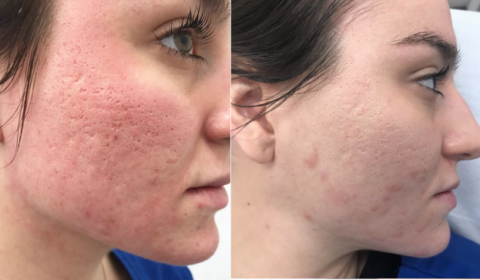Discovering Skin Problem: Determining and Treating Acne Scars for Healthier Skin
Acne marks stand for a substantial worry for people seeking to keep healthy skin, as they can influence both appearance and self-worth. Understanding the different types of scars, from atrophic to hypertrophic, is vital for figuring out ideal treatment options.
Recognizing Acne Scars

The body's all-natural recovery process can cause either atrophic marks, which look like clinical depressions in the skin, or hypertrophic marks, which are elevated and arise from overproduction of collagen. In addition, the mental toll of acne marks need to not be underestimated; many people report sensations of shame, stress and anxiety, and reduced self-worth. This psychological worry can affect social interactions and overall quality of life.
Attending to acne scars calls for a detailed understanding of their development and influence. Understanding of the capacity for lasting consequences connected with without treatment scars can inspire people to seek suitable treatments. Early treatment and reliable management techniques can substantially improve skin appearance and boost emotional resilience, emphasizing the value of understanding the intricacies bordering acne scars.
Sorts Of Acne Marks
Acne marks can be classified into unique types, each showing special attributes and requiring details treatment methods. skin rejuvenation treatments. The key kinds of acne scars include atrophic, hypertrophic, and keloid marks

Hypertrophic marks, in contrast, are raised over the skin level and are the result of extreme collagen production during the recovery procedure. They usually continue to be within the borders of the initial acne sore. Keloid marks are similar but prolong beyond the initial injury site, creating bigger, elevated locations that can be unpleasant or scratchy.
Comprehending these kinds of scars is crucial for choosing proper treatment choices. Various marks may respond better to details treatments, such as laser treatments, fillers, or medical treatments, emphasizing the significance of a customized strategy to acne scar administration.
Recognizing Your Scars
When evaluating the appearance of your skin, it is crucial to precisely recognize the kind of marks present, as this will inform one of the most effective treatment method. Acne marks usually come under two classifications: hypertrophic and atrophic marks. Atrophic marks, which are one of the most common, look like depressions or imprints on the skin. These can better be categorized into ice-pick scars, boxcar marks, and rolling scars, each showing distinctive features and requiring different techniques for analysis.
Hypertrophic marks, on the other hand, are raised and happen because of excessive collagen production throughout the healing process. Acknowledging the specific functions of your marks-- such as width, deepness, and structure-- is important for correct identification (acne scars treatment). Furthermore, think about the distribution of marks throughout your skin, as this can suggest the seriousness and duration of the acne problem
Involving with a dermatologist can give beneficial understandings right into the nature of your marks, helping in the distinction between various kinds. An extensive understanding of your marks will inevitably lead to a much more customized and efficient therapy plan, making certain a more clear and much healthier complexion.
Therapy Options Readily Available
Identifying the specific kind of acne scars present on your skin lays the groundwork for exploring effective treatment choices. Common kinds of acne marks include atrophic (depressed), hypertrophic (raised), and post-inflammatory erythema.
For atrophic marks, choices such as chemical peels, microneedling, and laser resurfacing are widely utilized. Chemical peels make use of acids to get click here now rid of the outer layer of skin, advertising brand-new cell development. Microneedling involves tiny needles that develop micro-injuries, boosting collagen manufacturing. Laser resurfacing targets harmed skin cells, enhancing texture and tone.
Hypertrophic marks can be treated with corticosteroid shots to squash the scar or laser therapy to minimize soreness and improve appearance. Silicone gel sheets and stress dressings may also aid in handling elevated marks.
On top of that, facial fillers can temporarily fill up in clinical depressions from atrophic marks, while medical excision may be ideal for severe cases. Each therapy option has its considerations and benefits, making it necessary to talk to a skin specialist. They can supply customized recommendations based on the kind and seriousness of your marks, along with your skin kind and general health and wellness.
Tips for Prevention
Reliable avoidance approaches can considerably reduce the chance of establishing acne have a peek here marks. Utilizing non-comedogenic items helps prevent clogged up pores, which can aggravate acne.
Staying clear of the impulse to stand out or pick acne lesions is crucial, as this can cause deeper skin damage and raise the threat of scarring. Rather, consider making use of a chilly compress or non-prescription treatments to minimize swelling and redness.
Sunlight defense is another important aspect of prevention; ultraviolet (UV) rays can dim scars and hinder the recovery process. Using a broad-spectrum sun block with at the very least SPF 30 daily can shield the skin and advertise also recovery.
Finally, preserving a well balanced diet abundant in minerals, vitamins, and antioxidants sustains skin wellness and healing. Remaining moisturized and taking care of stress levels can additionally play a significant duty in reducing acne flare-ups. By applying these methods, people can dramatically minimize their possibilities of developing acne scars.
Verdict
In conclusion, understanding and recognizing acne scars is vital for efficient therapy and achieving healthier skin. Different kinds of acne scars, including hypertrophic and atrophic scars, require specific interventions customized to specific requirements.
The body's all-natural recovery process can result in either atrophic scars, which show up as depressions in the skin, or hypertrophic marks, which are increased and result from overproduction of collagen. They are more divided into three subtypes: ice pick marks, boxcar marks, and rolling scars. Acne marks normally fall into two categories: hypertrophic and atrophic scars. These can further be identified into ice-pick marks, boxcar marks, and rolling scars, each exhibiting unique characteristics and calling for various approaches for analysis.
Different types of acne scars, consisting of hypertrophic and atrophic marks, necessitate certain treatments tailored go right here to individual requirements.